Analysing Strategic Capabilities: Ryanair
VerifiedAdded on 2023/06/09
|20
|5085
|326
AI Summary
The report aims to examine internal factors of Irish airline in order to understand how sustainable the company will be based on its strategic practices. Moreover, it includes possible opportunities that the organisation can explore with the purpose of making the future better.
Contribute Materials
Your contribution can guide someone’s learning journey. Share your
documents today.

Running head: ANALYSING STRATEGIC CAPABILITIES: RYANAIR
Analysing Strategic Capabilities: Ryanair
Name of the university
Name of the Student
Author name
Analysing Strategic Capabilities: Ryanair
Name of the university
Name of the Student
Author name
Secure Best Marks with AI Grader
Need help grading? Try our AI Grader for instant feedback on your assignments.
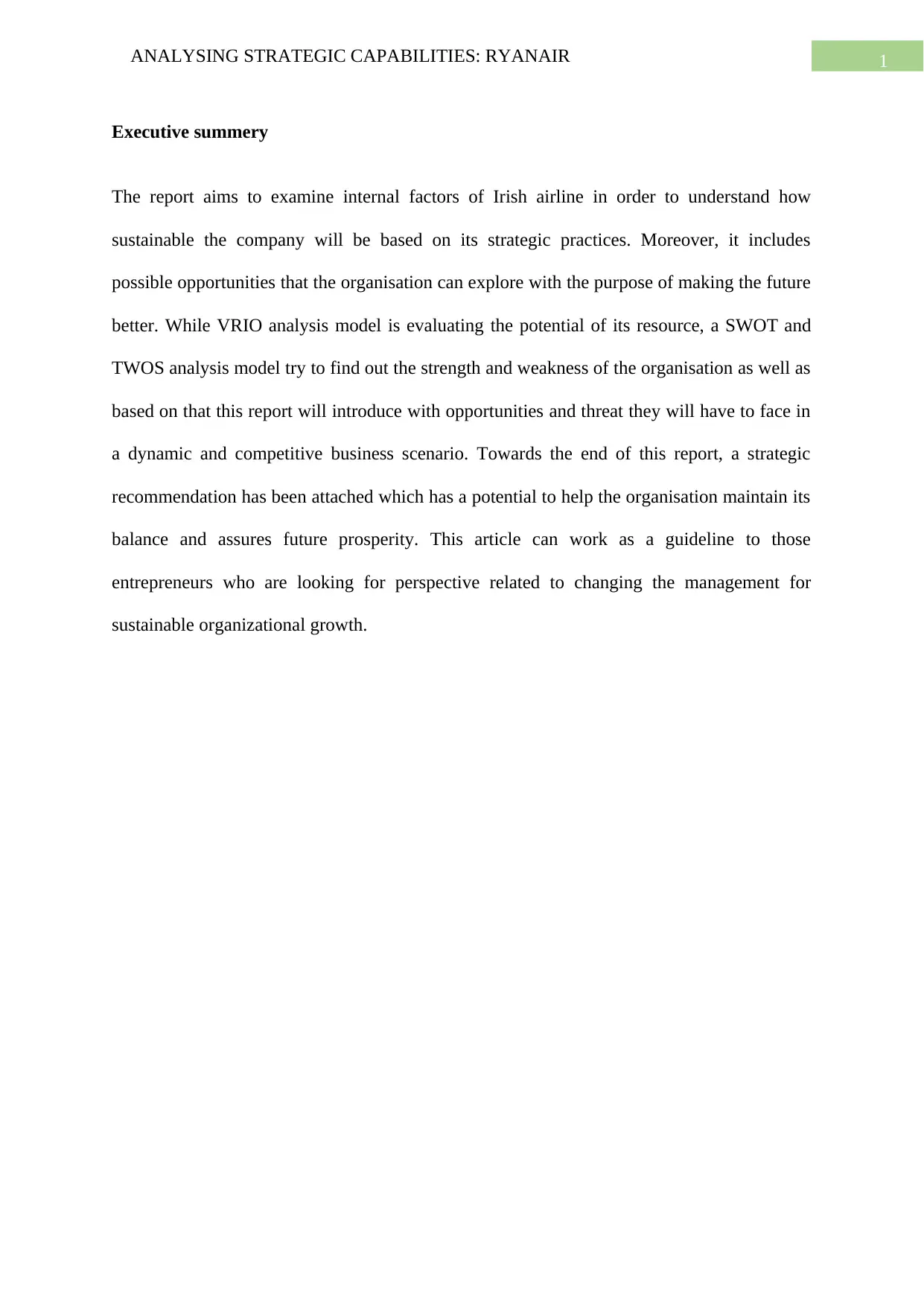
1ANALYSING STRATEGIC CAPABILITIES: RYANAIR
Executive summery
The report aims to examine internal factors of Irish airline in order to understand how
sustainable the company will be based on its strategic practices. Moreover, it includes
possible opportunities that the organisation can explore with the purpose of making the future
better. While VRIO analysis model is evaluating the potential of its resource, a SWOT and
TWOS analysis model try to find out the strength and weakness of the organisation as well as
based on that this report will introduce with opportunities and threat they will have to face in
a dynamic and competitive business scenario. Towards the end of this report, a strategic
recommendation has been attached which has a potential to help the organisation maintain its
balance and assures future prosperity. This article can work as a guideline to those
entrepreneurs who are looking for perspective related to changing the management for
sustainable organizational growth.
Executive summery
The report aims to examine internal factors of Irish airline in order to understand how
sustainable the company will be based on its strategic practices. Moreover, it includes
possible opportunities that the organisation can explore with the purpose of making the future
better. While VRIO analysis model is evaluating the potential of its resource, a SWOT and
TWOS analysis model try to find out the strength and weakness of the organisation as well as
based on that this report will introduce with opportunities and threat they will have to face in
a dynamic and competitive business scenario. Towards the end of this report, a strategic
recommendation has been attached which has a potential to help the organisation maintain its
balance and assures future prosperity. This article can work as a guideline to those
entrepreneurs who are looking for perspective related to changing the management for
sustainable organizational growth.
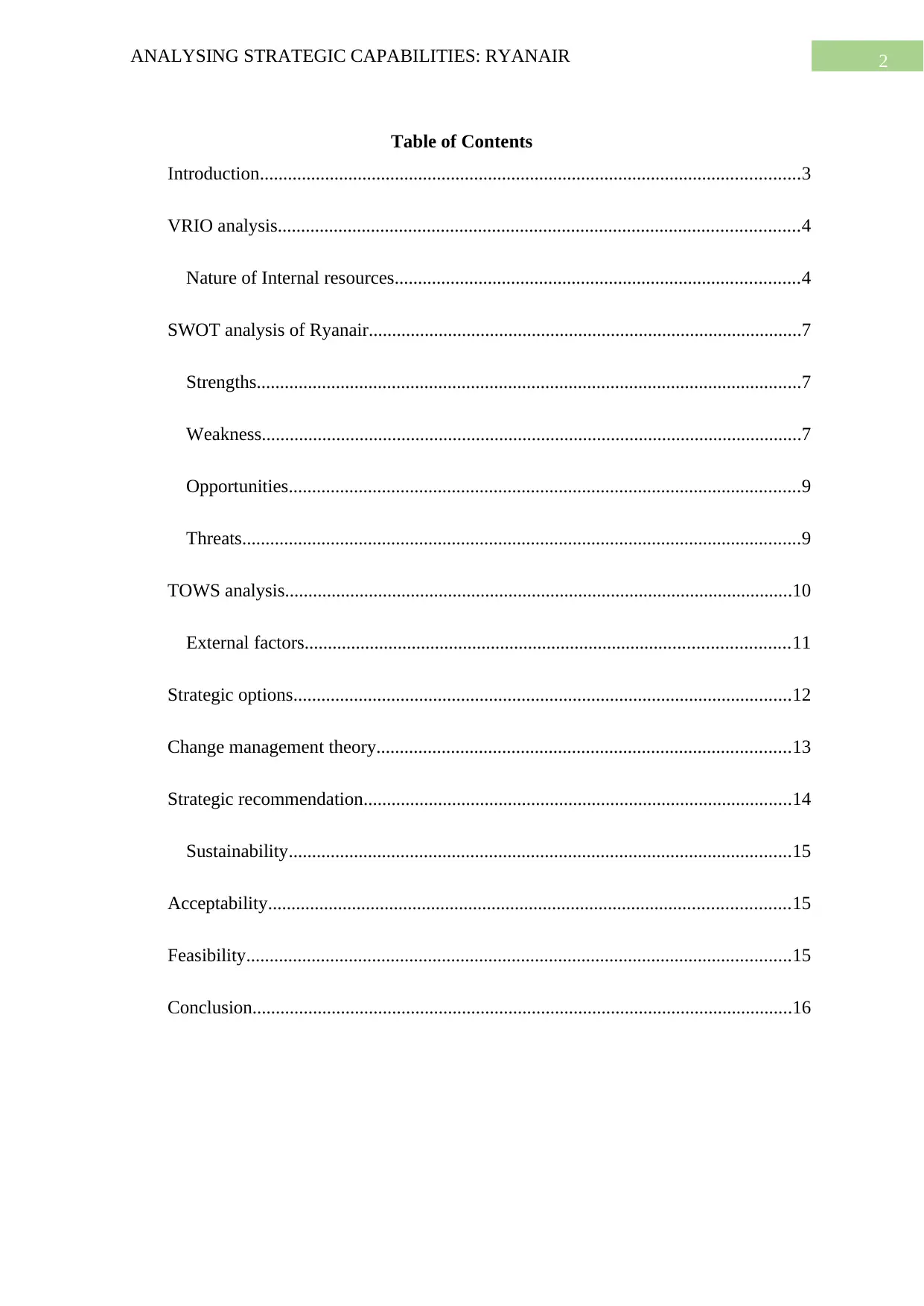
2ANALYSING STRATEGIC CAPABILITIES: RYANAIR
Table of Contents
Introduction....................................................................................................................3
VRIO analysis................................................................................................................4
Nature of Internal resources.......................................................................................4
SWOT analysis of Ryanair.............................................................................................7
Strengths.....................................................................................................................7
Weakness....................................................................................................................7
Opportunities..............................................................................................................9
Threats........................................................................................................................9
TOWS analysis.............................................................................................................10
External factors........................................................................................................11
Strategic options...........................................................................................................12
Change management theory.........................................................................................13
Strategic recommendation............................................................................................14
Sustainability............................................................................................................15
Acceptability................................................................................................................15
Feasibility.....................................................................................................................15
Conclusion....................................................................................................................16
Table of Contents
Introduction....................................................................................................................3
VRIO analysis................................................................................................................4
Nature of Internal resources.......................................................................................4
SWOT analysis of Ryanair.............................................................................................7
Strengths.....................................................................................................................7
Weakness....................................................................................................................7
Opportunities..............................................................................................................9
Threats........................................................................................................................9
TOWS analysis.............................................................................................................10
External factors........................................................................................................11
Strategic options...........................................................................................................12
Change management theory.........................................................................................13
Strategic recommendation............................................................................................14
Sustainability............................................................................................................15
Acceptability................................................................................................................15
Feasibility.....................................................................................................................15
Conclusion....................................................................................................................16
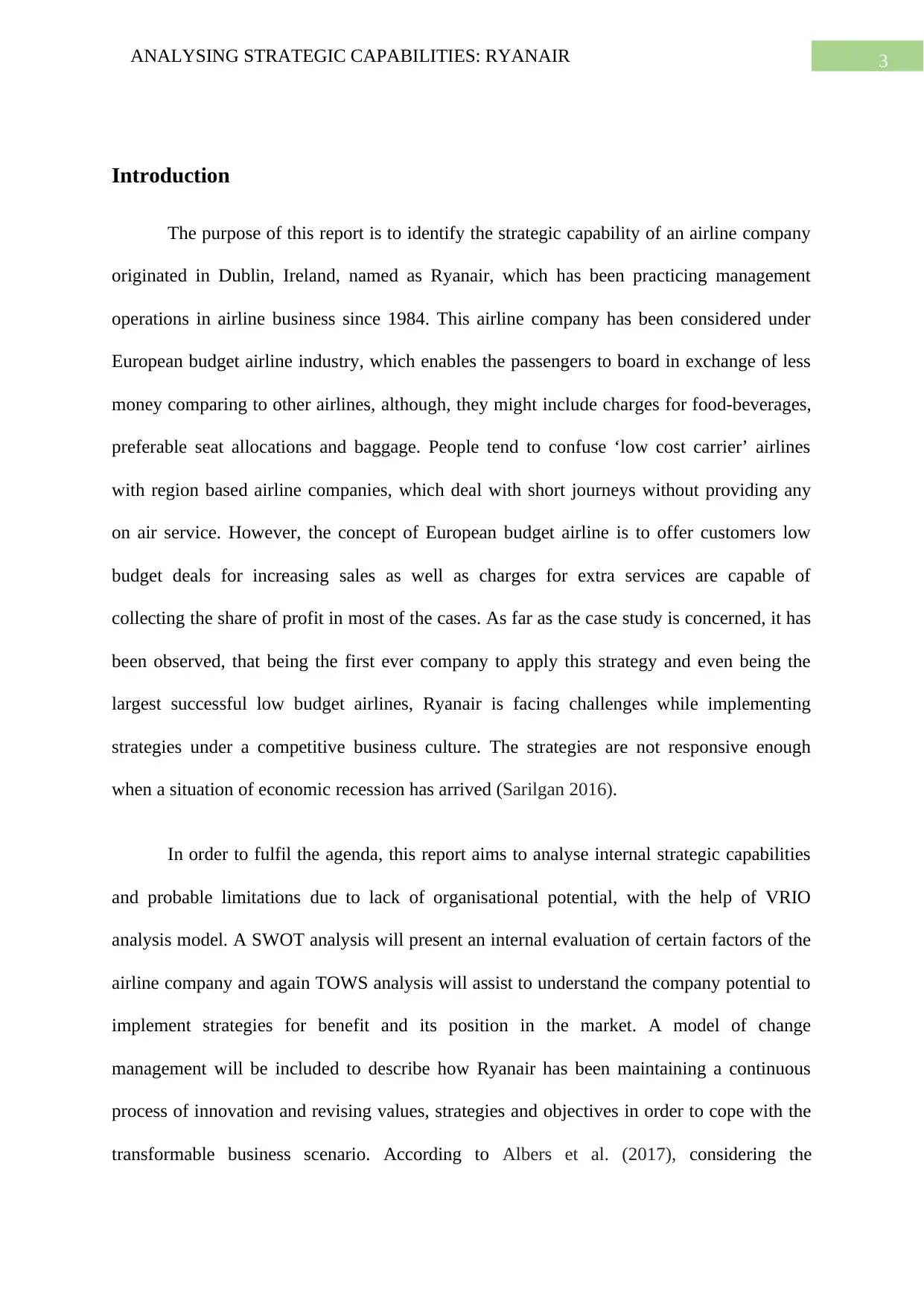
3ANALYSING STRATEGIC CAPABILITIES: RYANAIR
Introduction
The purpose of this report is to identify the strategic capability of an airline company
originated in Dublin, Ireland, named as Ryanair, which has been practicing management
operations in airline business since 1984. This airline company has been considered under
European budget airline industry, which enables the passengers to board in exchange of less
money comparing to other airlines, although, they might include charges for food-beverages,
preferable seat allocations and baggage. People tend to confuse ‘low cost carrier’ airlines
with region based airline companies, which deal with short journeys without providing any
on air service. However, the concept of European budget airline is to offer customers low
budget deals for increasing sales as well as charges for extra services are capable of
collecting the share of profit in most of the cases. As far as the case study is concerned, it has
been observed, that being the first ever company to apply this strategy and even being the
largest successful low budget airlines, Ryanair is facing challenges while implementing
strategies under a competitive business culture. The strategies are not responsive enough
when a situation of economic recession has arrived (Sarilgan 2016).
In order to fulfil the agenda, this report aims to analyse internal strategic capabilities
and probable limitations due to lack of organisational potential, with the help of VRIO
analysis model. A SWOT analysis will present an internal evaluation of certain factors of the
airline company and again TOWS analysis will assist to understand the company potential to
implement strategies for benefit and its position in the market. A model of change
management will be included to describe how Ryanair has been maintaining a continuous
process of innovation and revising values, strategies and objectives in order to cope with the
transformable business scenario. According to Albers et al. (2017), considering the
Introduction
The purpose of this report is to identify the strategic capability of an airline company
originated in Dublin, Ireland, named as Ryanair, which has been practicing management
operations in airline business since 1984. This airline company has been considered under
European budget airline industry, which enables the passengers to board in exchange of less
money comparing to other airlines, although, they might include charges for food-beverages,
preferable seat allocations and baggage. People tend to confuse ‘low cost carrier’ airlines
with region based airline companies, which deal with short journeys without providing any
on air service. However, the concept of European budget airline is to offer customers low
budget deals for increasing sales as well as charges for extra services are capable of
collecting the share of profit in most of the cases. As far as the case study is concerned, it has
been observed, that being the first ever company to apply this strategy and even being the
largest successful low budget airlines, Ryanair is facing challenges while implementing
strategies under a competitive business culture. The strategies are not responsive enough
when a situation of economic recession has arrived (Sarilgan 2016).
In order to fulfil the agenda, this report aims to analyse internal strategic capabilities
and probable limitations due to lack of organisational potential, with the help of VRIO
analysis model. A SWOT analysis will present an internal evaluation of certain factors of the
airline company and again TOWS analysis will assist to understand the company potential to
implement strategies for benefit and its position in the market. A model of change
management will be included to describe how Ryanair has been maintaining a continuous
process of innovation and revising values, strategies and objectives in order to cope with the
transformable business scenario. According to Albers et al. (2017), considering the
Secure Best Marks with AI Grader
Need help grading? Try our AI Grader for instant feedback on your assignments.

4ANALYSING STRATEGIC CAPABILITIES: RYANAIR
contemporary market environment, strategic recommendations will be developed, not only
that towards the end of this report an overview of the case will be attached to gain a distinct
perception over the matter.
VRIO analysis
This framework works as a tool to evaluate an organisation’s internal resources and
strategic capabilities to develop an understanding whether those factors can contribute in the
process of gaining a sustainable competitive advantage within the industry. The author of this
analysis model introduced four aspects, which have been judged in order to find out the
potential of the resources. The concept of VRIO is combination of four aspects, such as,
valuable resources, which are rare too and non-imitable or too costly to imitate for the
competitors. A firm should be organized enough in terms of work process, policies and
hierarchical structure to make the best use of its resources.
Following the market trend of low-cost services, Ryanair experienced immense
success. In fact, they were nominated under ‘World’s favourite Airline’ as they carried more
international passengers than any other airline brand(). Despite carrying highest number of
passengers the company experienced huge loss and faced several challenges towards the end
of 1990, therefore, strategies are proved to be inactive or questionable in the backdrop of
dynamic business environment, which includes incidents of economic recession or
fluctuation of fuel price. As described in VRIO analysis model, whether Ryanair is capable of
utilizing the opportunities with the help of its resources or not that should be evaluated first.
Nature of Internal resources
With the purpose of delivering efficient services to the customers better than rival
airlines, Ryanair has eliminated several procedures from operation list, which were not
contemporary market environment, strategic recommendations will be developed, not only
that towards the end of this report an overview of the case will be attached to gain a distinct
perception over the matter.
VRIO analysis
This framework works as a tool to evaluate an organisation’s internal resources and
strategic capabilities to develop an understanding whether those factors can contribute in the
process of gaining a sustainable competitive advantage within the industry. The author of this
analysis model introduced four aspects, which have been judged in order to find out the
potential of the resources. The concept of VRIO is combination of four aspects, such as,
valuable resources, which are rare too and non-imitable or too costly to imitate for the
competitors. A firm should be organized enough in terms of work process, policies and
hierarchical structure to make the best use of its resources.
Following the market trend of low-cost services, Ryanair experienced immense
success. In fact, they were nominated under ‘World’s favourite Airline’ as they carried more
international passengers than any other airline brand(). Despite carrying highest number of
passengers the company experienced huge loss and faced several challenges towards the end
of 1990, therefore, strategies are proved to be inactive or questionable in the backdrop of
dynamic business environment, which includes incidents of economic recession or
fluctuation of fuel price. As described in VRIO analysis model, whether Ryanair is capable of
utilizing the opportunities with the help of its resources or not that should be evaluated first.
Nature of Internal resources
With the purpose of delivering efficient services to the customers better than rival
airlines, Ryanair has eliminated several procedures from operation list, which were not
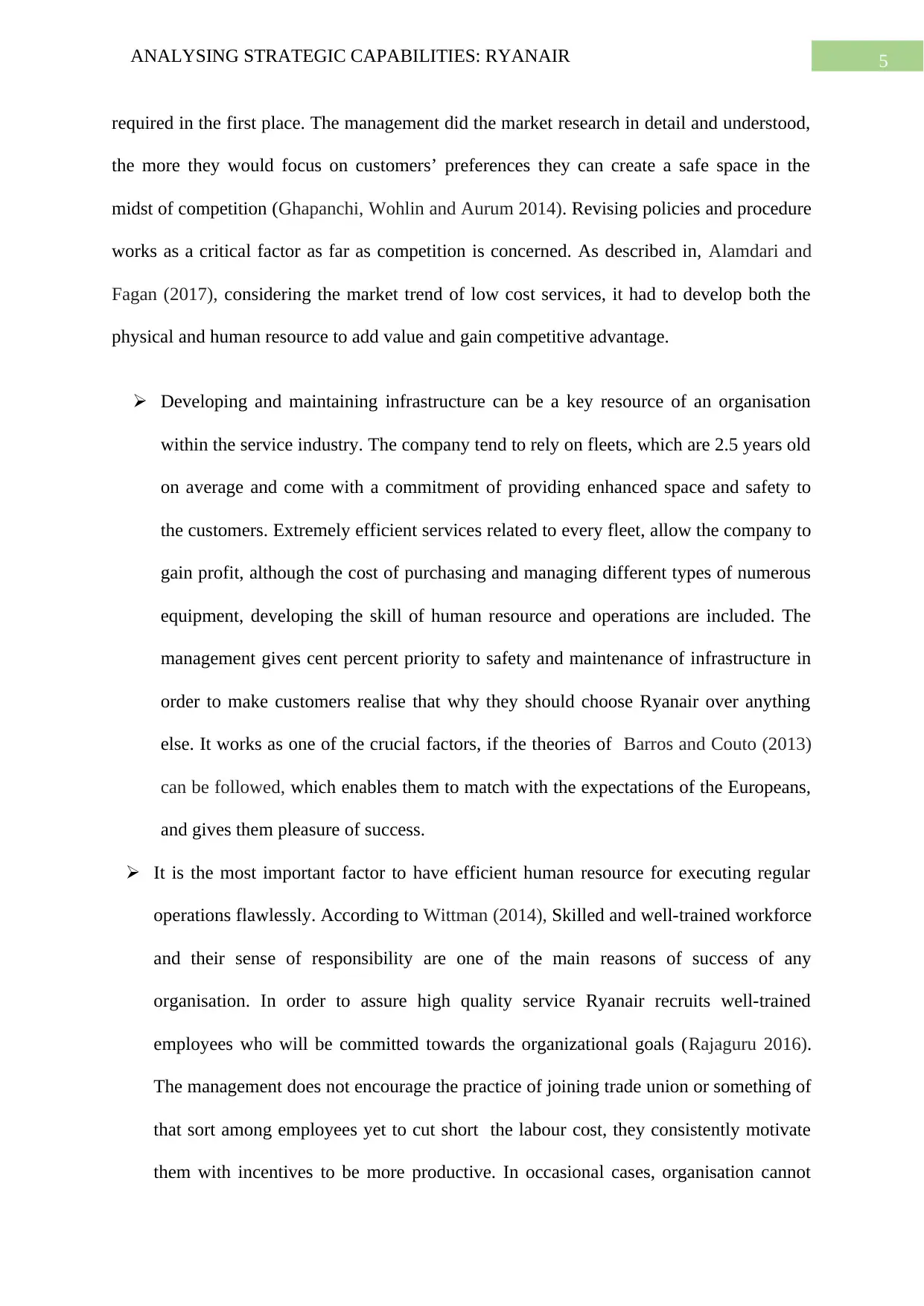
5ANALYSING STRATEGIC CAPABILITIES: RYANAIR
required in the first place. The management did the market research in detail and understood,
the more they would focus on customers’ preferences they can create a safe space in the
midst of competition (Ghapanchi, Wohlin and Aurum 2014). Revising policies and procedure
works as a critical factor as far as competition is concerned. As described in, Alamdari and
Fagan (2017), considering the market trend of low cost services, it had to develop both the
physical and human resource to add value and gain competitive advantage.
Developing and maintaining infrastructure can be a key resource of an organisation
within the service industry. The company tend to rely on fleets, which are 2.5 years old
on average and come with a commitment of providing enhanced space and safety to
the customers. Extremely efficient services related to every fleet, allow the company to
gain profit, although the cost of purchasing and managing different types of numerous
equipment, developing the skill of human resource and operations are included. The
management gives cent percent priority to safety and maintenance of infrastructure in
order to make customers realise that why they should choose Ryanair over anything
else. It works as one of the crucial factors, if the theories of Barros and Couto (2013)
can be followed, which enables them to match with the expectations of the Europeans,
and gives them pleasure of success.
It is the most important factor to have efficient human resource for executing regular
operations flawlessly. According to Wittman (2014), Skilled and well-trained workforce
and their sense of responsibility are one of the main reasons of success of any
organisation. In order to assure high quality service Ryanair recruits well-trained
employees who will be committed towards the organizational goals (Rajaguru 2016).
The management does not encourage the practice of joining trade union or something of
that sort among employees yet to cut short the labour cost, they consistently motivate
them with incentives to be more productive. In occasional cases, organisation cannot
required in the first place. The management did the market research in detail and understood,
the more they would focus on customers’ preferences they can create a safe space in the
midst of competition (Ghapanchi, Wohlin and Aurum 2014). Revising policies and procedure
works as a critical factor as far as competition is concerned. As described in, Alamdari and
Fagan (2017), considering the market trend of low cost services, it had to develop both the
physical and human resource to add value and gain competitive advantage.
Developing and maintaining infrastructure can be a key resource of an organisation
within the service industry. The company tend to rely on fleets, which are 2.5 years old
on average and come with a commitment of providing enhanced space and safety to
the customers. Extremely efficient services related to every fleet, allow the company to
gain profit, although the cost of purchasing and managing different types of numerous
equipment, developing the skill of human resource and operations are included. The
management gives cent percent priority to safety and maintenance of infrastructure in
order to make customers realise that why they should choose Ryanair over anything
else. It works as one of the crucial factors, if the theories of Barros and Couto (2013)
can be followed, which enables them to match with the expectations of the Europeans,
and gives them pleasure of success.
It is the most important factor to have efficient human resource for executing regular
operations flawlessly. According to Wittman (2014), Skilled and well-trained workforce
and their sense of responsibility are one of the main reasons of success of any
organisation. In order to assure high quality service Ryanair recruits well-trained
employees who will be committed towards the organizational goals (Rajaguru 2016).
The management does not encourage the practice of joining trade union or something of
that sort among employees yet to cut short the labour cost, they consistently motivate
them with incentives to be more productive. In occasional cases, organisation cannot
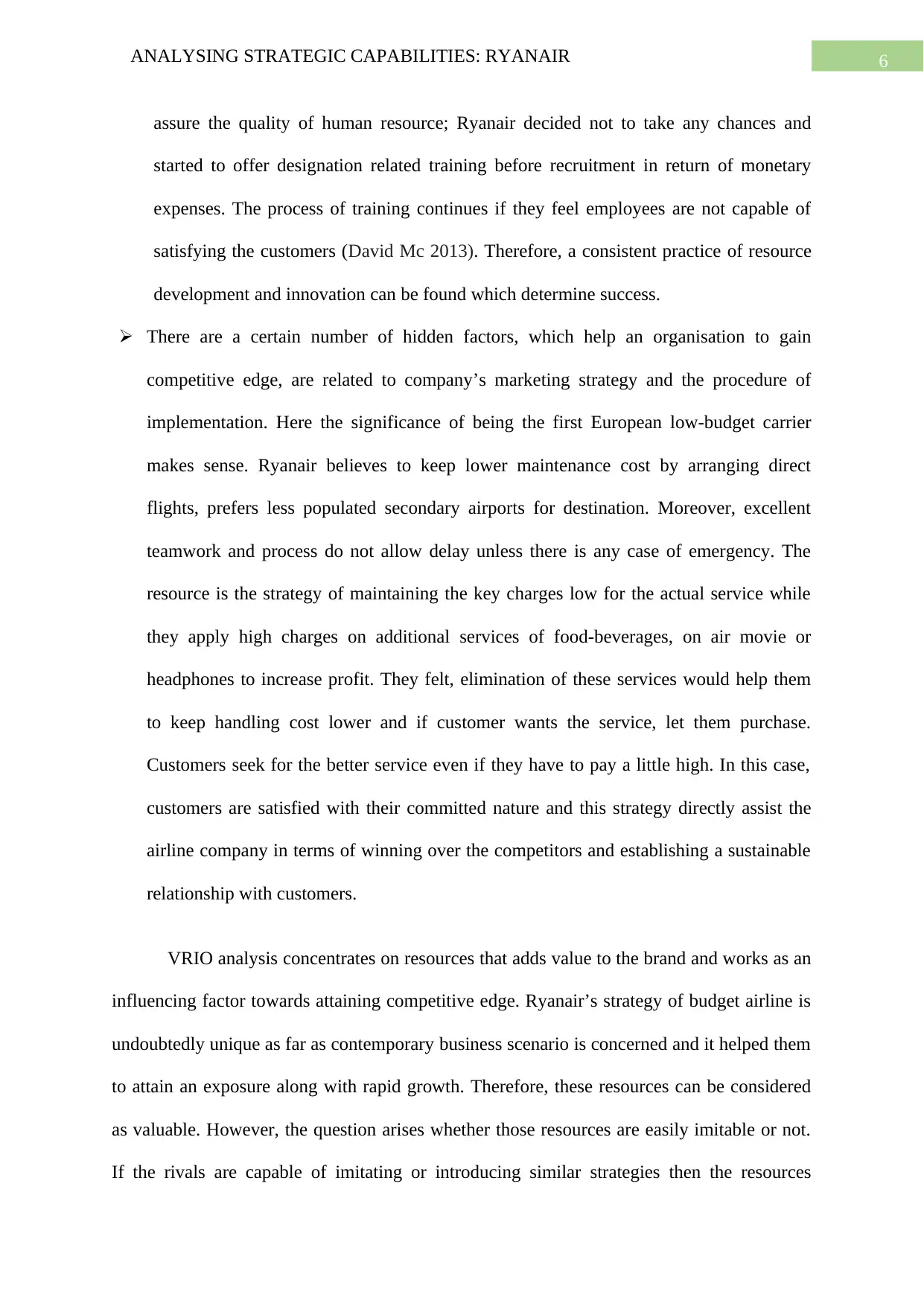
6ANALYSING STRATEGIC CAPABILITIES: RYANAIR
assure the quality of human resource; Ryanair decided not to take any chances and
started to offer designation related training before recruitment in return of monetary
expenses. The process of training continues if they feel employees are not capable of
satisfying the customers (David Mc 2013). Therefore, a consistent practice of resource
development and innovation can be found which determine success.
There are a certain number of hidden factors, which help an organisation to gain
competitive edge, are related to company’s marketing strategy and the procedure of
implementation. Here the significance of being the first European low-budget carrier
makes sense. Ryanair believes to keep lower maintenance cost by arranging direct
flights, prefers less populated secondary airports for destination. Moreover, excellent
teamwork and process do not allow delay unless there is any case of emergency. The
resource is the strategy of maintaining the key charges low for the actual service while
they apply high charges on additional services of food-beverages, on air movie or
headphones to increase profit. They felt, elimination of these services would help them
to keep handling cost lower and if customer wants the service, let them purchase.
Customers seek for the better service even if they have to pay a little high. In this case,
customers are satisfied with their committed nature and this strategy directly assist the
airline company in terms of winning over the competitors and establishing a sustainable
relationship with customers.
VRIO analysis concentrates on resources that adds value to the brand and works as an
influencing factor towards attaining competitive edge. Ryanair’s strategy of budget airline is
undoubtedly unique as far as contemporary business scenario is concerned and it helped them
to attain an exposure along with rapid growth. Therefore, these resources can be considered
as valuable. However, the question arises whether those resources are easily imitable or not.
If the rivals are capable of imitating or introducing similar strategies then the resources
assure the quality of human resource; Ryanair decided not to take any chances and
started to offer designation related training before recruitment in return of monetary
expenses. The process of training continues if they feel employees are not capable of
satisfying the customers (David Mc 2013). Therefore, a consistent practice of resource
development and innovation can be found which determine success.
There are a certain number of hidden factors, which help an organisation to gain
competitive edge, are related to company’s marketing strategy and the procedure of
implementation. Here the significance of being the first European low-budget carrier
makes sense. Ryanair believes to keep lower maintenance cost by arranging direct
flights, prefers less populated secondary airports for destination. Moreover, excellent
teamwork and process do not allow delay unless there is any case of emergency. The
resource is the strategy of maintaining the key charges low for the actual service while
they apply high charges on additional services of food-beverages, on air movie or
headphones to increase profit. They felt, elimination of these services would help them
to keep handling cost lower and if customer wants the service, let them purchase.
Customers seek for the better service even if they have to pay a little high. In this case,
customers are satisfied with their committed nature and this strategy directly assist the
airline company in terms of winning over the competitors and establishing a sustainable
relationship with customers.
VRIO analysis concentrates on resources that adds value to the brand and works as an
influencing factor towards attaining competitive edge. Ryanair’s strategy of budget airline is
undoubtedly unique as far as contemporary business scenario is concerned and it helped them
to attain an exposure along with rapid growth. Therefore, these resources can be considered
as valuable. However, the question arises whether those resources are easily imitable or not.
If the rivals are capable of imitating or introducing similar strategies then the resources
Paraphrase This Document
Need a fresh take? Get an instant paraphrase of this document with our AI Paraphraser
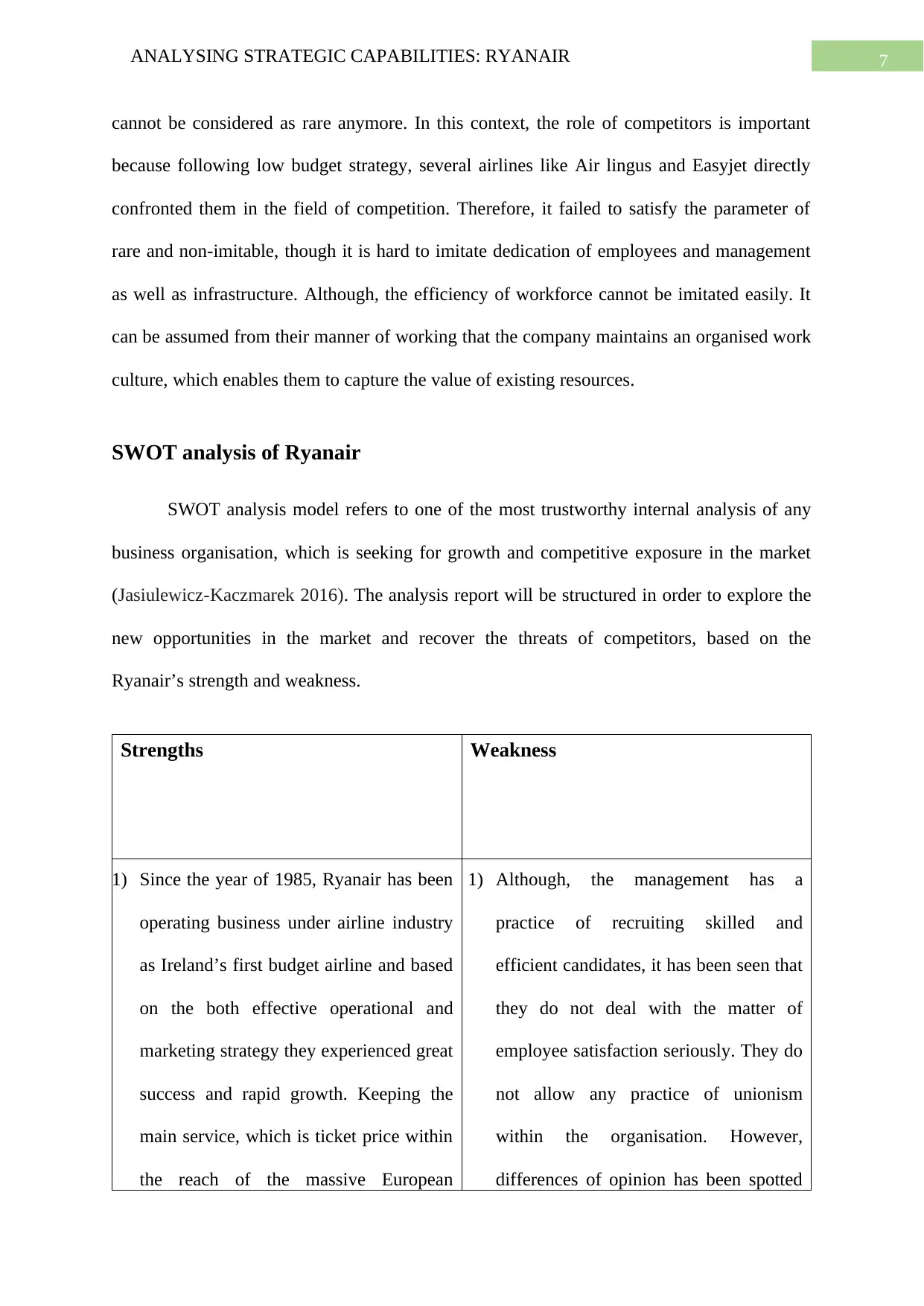
7ANALYSING STRATEGIC CAPABILITIES: RYANAIR
cannot be considered as rare anymore. In this context, the role of competitors is important
because following low budget strategy, several airlines like Air lingus and Easyjet directly
confronted them in the field of competition. Therefore, it failed to satisfy the parameter of
rare and non-imitable, though it is hard to imitate dedication of employees and management
as well as infrastructure. Although, the efficiency of workforce cannot be imitated easily. It
can be assumed from their manner of working that the company maintains an organised work
culture, which enables them to capture the value of existing resources.
SWOT analysis of Ryanair
SWOT analysis model refers to one of the most trustworthy internal analysis of any
business organisation, which is seeking for growth and competitive exposure in the market
(Jasiulewicz-Kaczmarek 2016). The analysis report will be structured in order to explore the
new opportunities in the market and recover the threats of competitors, based on the
Ryanair’s strength and weakness.
Strengths Weakness
1) Since the year of 1985, Ryanair has been
operating business under airline industry
as Ireland’s first budget airline and based
on the both effective operational and
marketing strategy they experienced great
success and rapid growth. Keeping the
main service, which is ticket price within
the reach of the massive European
1) Although, the management has a
practice of recruiting skilled and
efficient candidates, it has been seen that
they do not deal with the matter of
employee satisfaction seriously. They do
not allow any practice of unionism
within the organisation. However,
differences of opinion has been spotted
cannot be considered as rare anymore. In this context, the role of competitors is important
because following low budget strategy, several airlines like Air lingus and Easyjet directly
confronted them in the field of competition. Therefore, it failed to satisfy the parameter of
rare and non-imitable, though it is hard to imitate dedication of employees and management
as well as infrastructure. Although, the efficiency of workforce cannot be imitated easily. It
can be assumed from their manner of working that the company maintains an organised work
culture, which enables them to capture the value of existing resources.
SWOT analysis of Ryanair
SWOT analysis model refers to one of the most trustworthy internal analysis of any
business organisation, which is seeking for growth and competitive exposure in the market
(Jasiulewicz-Kaczmarek 2016). The analysis report will be structured in order to explore the
new opportunities in the market and recover the threats of competitors, based on the
Ryanair’s strength and weakness.
Strengths Weakness
1) Since the year of 1985, Ryanair has been
operating business under airline industry
as Ireland’s first budget airline and based
on the both effective operational and
marketing strategy they experienced great
success and rapid growth. Keeping the
main service, which is ticket price within
the reach of the massive European
1) Although, the management has a
practice of recruiting skilled and
efficient candidates, it has been seen that
they do not deal with the matter of
employee satisfaction seriously. They do
not allow any practice of unionism
within the organisation. However,
differences of opinion has been spotted
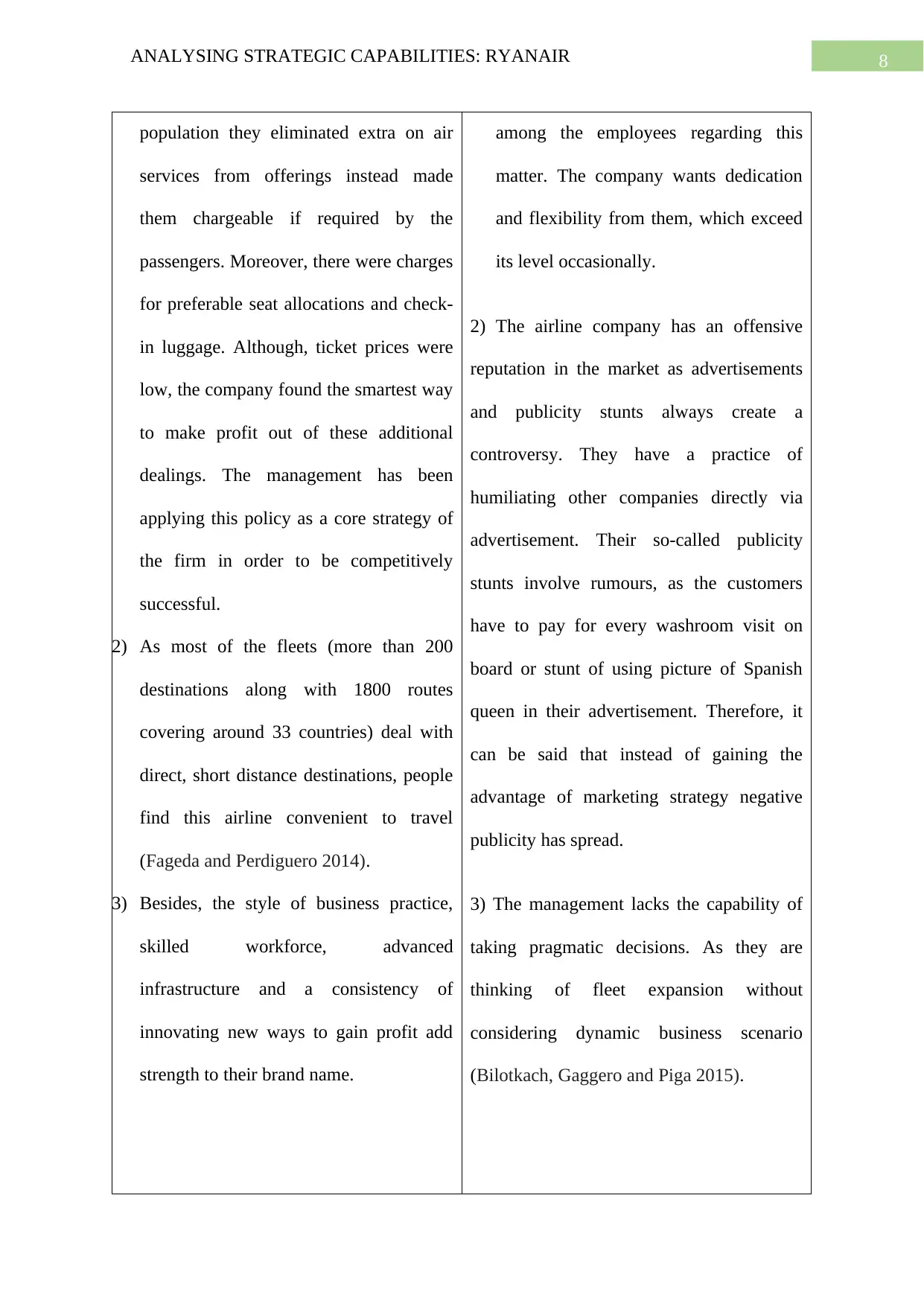
8ANALYSING STRATEGIC CAPABILITIES: RYANAIR
population they eliminated extra on air
services from offerings instead made
them chargeable if required by the
passengers. Moreover, there were charges
for preferable seat allocations and check-
in luggage. Although, ticket prices were
low, the company found the smartest way
to make profit out of these additional
dealings. The management has been
applying this policy as a core strategy of
the firm in order to be competitively
successful.
2) As most of the fleets (more than 200
destinations along with 1800 routes
covering around 33 countries) deal with
direct, short distance destinations, people
find this airline convenient to travel
(Fageda and Perdiguero 2014).
3) Besides, the style of business practice,
skilled workforce, advanced
infrastructure and a consistency of
innovating new ways to gain profit add
strength to their brand name.
among the employees regarding this
matter. The company wants dedication
and flexibility from them, which exceed
its level occasionally.
2) The airline company has an offensive
reputation in the market as advertisements
and publicity stunts always create a
controversy. They have a practice of
humiliating other companies directly via
advertisement. Their so-called publicity
stunts involve rumours, as the customers
have to pay for every washroom visit on
board or stunt of using picture of Spanish
queen in their advertisement. Therefore, it
can be said that instead of gaining the
advantage of marketing strategy negative
publicity has spread.
3) The management lacks the capability of
taking pragmatic decisions. As they are
thinking of fleet expansion without
considering dynamic business scenario
(Bilotkach, Gaggero and Piga 2015).
population they eliminated extra on air
services from offerings instead made
them chargeable if required by the
passengers. Moreover, there were charges
for preferable seat allocations and check-
in luggage. Although, ticket prices were
low, the company found the smartest way
to make profit out of these additional
dealings. The management has been
applying this policy as a core strategy of
the firm in order to be competitively
successful.
2) As most of the fleets (more than 200
destinations along with 1800 routes
covering around 33 countries) deal with
direct, short distance destinations, people
find this airline convenient to travel
(Fageda and Perdiguero 2014).
3) Besides, the style of business practice,
skilled workforce, advanced
infrastructure and a consistency of
innovating new ways to gain profit add
strength to their brand name.
among the employees regarding this
matter. The company wants dedication
and flexibility from them, which exceed
its level occasionally.
2) The airline company has an offensive
reputation in the market as advertisements
and publicity stunts always create a
controversy. They have a practice of
humiliating other companies directly via
advertisement. Their so-called publicity
stunts involve rumours, as the customers
have to pay for every washroom visit on
board or stunt of using picture of Spanish
queen in their advertisement. Therefore, it
can be said that instead of gaining the
advantage of marketing strategy negative
publicity has spread.
3) The management lacks the capability of
taking pragmatic decisions. As they are
thinking of fleet expansion without
considering dynamic business scenario
(Bilotkach, Gaggero and Piga 2015).

9ANALYSING STRATEGIC CAPABILITIES: RYANAIR
Opportunities Threats
1) As Ryanair has already experienced
success and possesses both the monetary
and human resources, they can think of
international expansion instead of going
for a fleet expansion. Although, negative
publicity has been spread, yet customers
appreciate their service within the
budget. Based on the brand name they
have opportunity to expand business
across Asia and other favourable
continents.
2) Opportunity of raising the price of
additional on board services is present.
3) There are issues of customer loyalty
though, yet if they can make effective
changes and adopt innovation based on
customer preferences as described in
Budd et al. (2014), there is opportunity
for betterment.
1) One of the major threats is emergence of
new airlines with the same low budget
policy. In order to gain a safe space
amidst of such competitive environment
if Ryanair does not feel to revise the
policies and introduce innovative ideas
then in future there is a chance of
strategy failure (Francis, Humphreys and
Aicken 2017).
2) It has been noticed that budget airlines
confronts with several challenges under
external crisis. For instance, recession in
Europe or the fluctuation of fuel price.
The company may suffer if management
would not think for alternatives.
3) As Ryanair carries highest volume of
both the national and international
passengers as per the report of Clewlow,
Sussman and Balakrishnan (2014), they
are on the verge of fleet expansion
Opportunities Threats
1) As Ryanair has already experienced
success and possesses both the monetary
and human resources, they can think of
international expansion instead of going
for a fleet expansion. Although, negative
publicity has been spread, yet customers
appreciate their service within the
budget. Based on the brand name they
have opportunity to expand business
across Asia and other favourable
continents.
2) Opportunity of raising the price of
additional on board services is present.
3) There are issues of customer loyalty
though, yet if they can make effective
changes and adopt innovation based on
customer preferences as described in
Budd et al. (2014), there is opportunity
for betterment.
1) One of the major threats is emergence of
new airlines with the same low budget
policy. In order to gain a safe space
amidst of such competitive environment
if Ryanair does not feel to revise the
policies and introduce innovative ideas
then in future there is a chance of
strategy failure (Francis, Humphreys and
Aicken 2017).
2) It has been noticed that budget airlines
confronts with several challenges under
external crisis. For instance, recession in
Europe or the fluctuation of fuel price.
The company may suffer if management
would not think for alternatives.
3) As Ryanair carries highest volume of
both the national and international
passengers as per the report of Clewlow,
Sussman and Balakrishnan (2014), they
are on the verge of fleet expansion
Secure Best Marks with AI Grader
Need help grading? Try our AI Grader for instant feedback on your assignments.

10ANALYSING STRATEGIC CAPABILITIES: RYANAIR
according to that. However, the decision
is not pragmatic, as the external
environmental factors possess dynamic
characteristics. Due to that if target
market decreases in size, the company
might experience major financial
disturbance.
Based on its strength and weakness, Ryanair’s opportunity and threat has been
identified as of now. However, based on its threat and opportunity, the company’s weakness
and strength will be evaluated. TOWS analysis will deliver a perception that to which extent
Ryanair can improvise norms to explore the opportunities along with that whether it can
overcome threats based on its strength.
TOWS analysis
Twos analysis model helps a business organisation to identify various strategic
options. The company can develop an understanding of market opportunity based on its
strength as well as find out ideas to deal with the flaws. As far as external factors are
concerned, as per Singh and Sushil, (2013), recognising the opportunity the organisation try
to improve areas of weakness along with that they try to eliminate the probable threats.
according to that. However, the decision
is not pragmatic, as the external
environmental factors possess dynamic
characteristics. Due to that if target
market decreases in size, the company
might experience major financial
disturbance.
Based on its strength and weakness, Ryanair’s opportunity and threat has been
identified as of now. However, based on its threat and opportunity, the company’s weakness
and strength will be evaluated. TOWS analysis will deliver a perception that to which extent
Ryanair can improvise norms to explore the opportunities along with that whether it can
overcome threats based on its strength.
TOWS analysis
Twos analysis model helps a business organisation to identify various strategic
options. The company can develop an understanding of market opportunity based on its
strength as well as find out ideas to deal with the flaws. As far as external factors are
concerned, as per Singh and Sushil, (2013), recognising the opportunity the organisation try
to improve areas of weakness along with that they try to eliminate the probable threats.
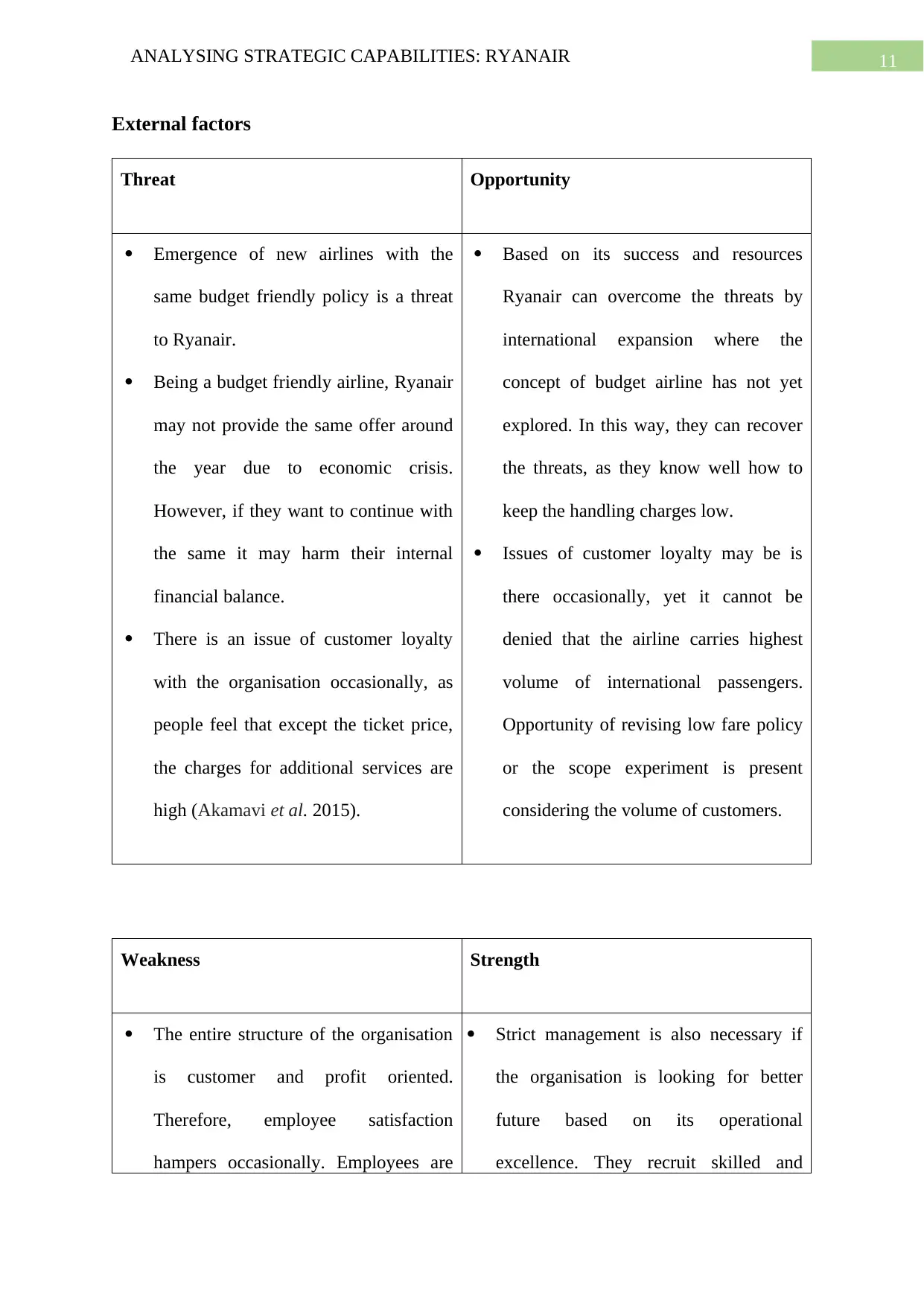
11ANALYSING STRATEGIC CAPABILITIES: RYANAIR
External factors
Threat Opportunity
Emergence of new airlines with the
same budget friendly policy is a threat
to Ryanair.
Being a budget friendly airline, Ryanair
may not provide the same offer around
the year due to economic crisis.
However, if they want to continue with
the same it may harm their internal
financial balance.
There is an issue of customer loyalty
with the organisation occasionally, as
people feel that except the ticket price,
the charges for additional services are
high (Akamavi et al. 2015).
Based on its success and resources
Ryanair can overcome the threats by
international expansion where the
concept of budget airline has not yet
explored. In this way, they can recover
the threats, as they know well how to
keep the handling charges low.
Issues of customer loyalty may be is
there occasionally, yet it cannot be
denied that the airline carries highest
volume of international passengers.
Opportunity of revising low fare policy
or the scope experiment is present
considering the volume of customers.
Weakness Strength
The entire structure of the organisation
is customer and profit oriented.
Therefore, employee satisfaction
hampers occasionally. Employees are
Strict management is also necessary if
the organisation is looking for better
future based on its operational
excellence. They recruit skilled and
External factors
Threat Opportunity
Emergence of new airlines with the
same budget friendly policy is a threat
to Ryanair.
Being a budget friendly airline, Ryanair
may not provide the same offer around
the year due to economic crisis.
However, if they want to continue with
the same it may harm their internal
financial balance.
There is an issue of customer loyalty
with the organisation occasionally, as
people feel that except the ticket price,
the charges for additional services are
high (Akamavi et al. 2015).
Based on its success and resources
Ryanair can overcome the threats by
international expansion where the
concept of budget airline has not yet
explored. In this way, they can recover
the threats, as they know well how to
keep the handling charges low.
Issues of customer loyalty may be is
there occasionally, yet it cannot be
denied that the airline carries highest
volume of international passengers.
Opportunity of revising low fare policy
or the scope experiment is present
considering the volume of customers.
Weakness Strength
The entire structure of the organisation
is customer and profit oriented.
Therefore, employee satisfaction
hampers occasionally. Employees are
Strict management is also necessary if
the organisation is looking for better
future based on its operational
excellence. They recruit skilled and
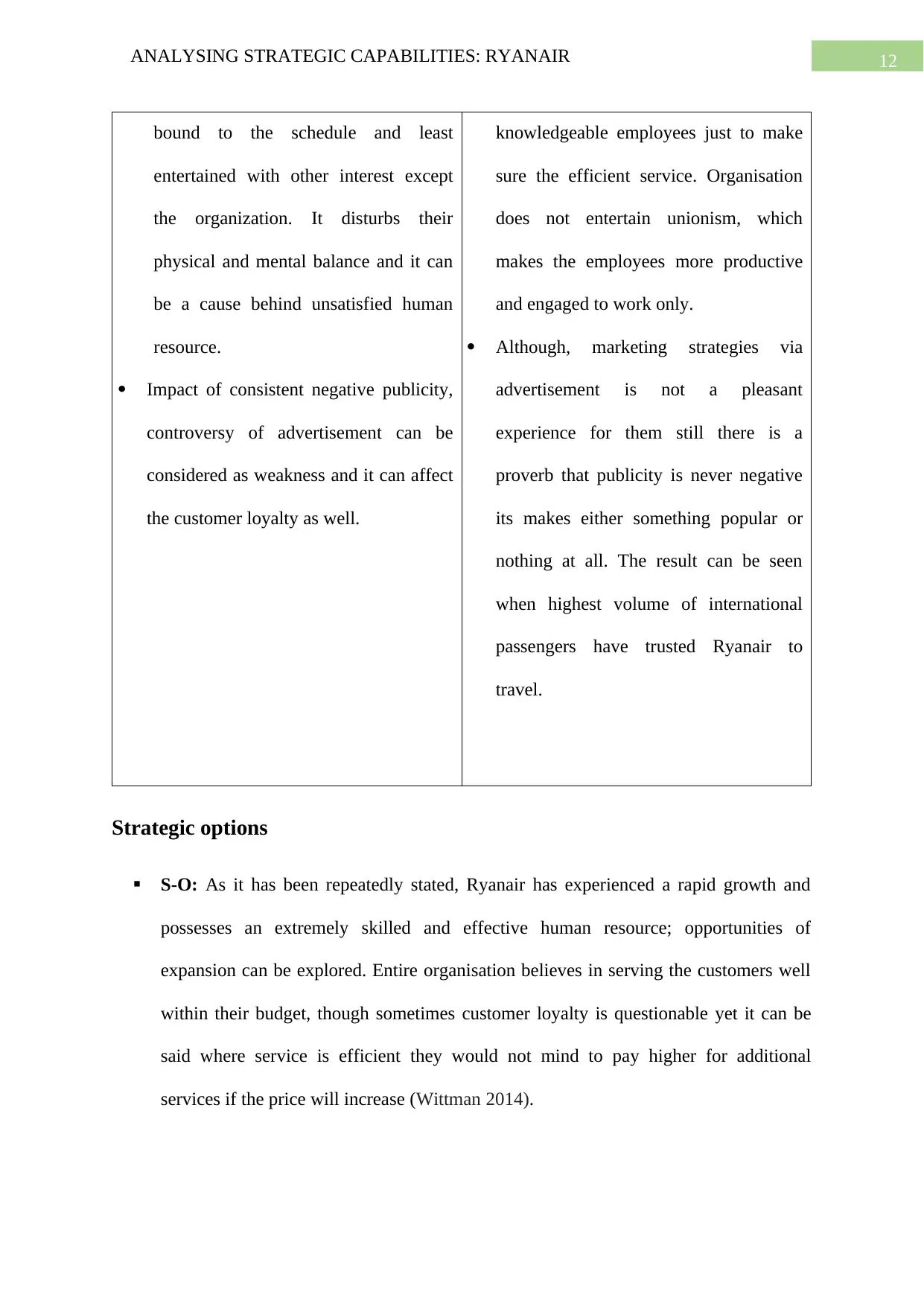
12ANALYSING STRATEGIC CAPABILITIES: RYANAIR
bound to the schedule and least
entertained with other interest except
the organization. It disturbs their
physical and mental balance and it can
be a cause behind unsatisfied human
resource.
Impact of consistent negative publicity,
controversy of advertisement can be
considered as weakness and it can affect
the customer loyalty as well.
knowledgeable employees just to make
sure the efficient service. Organisation
does not entertain unionism, which
makes the employees more productive
and engaged to work only.
Although, marketing strategies via
advertisement is not a pleasant
experience for them still there is a
proverb that publicity is never negative
its makes either something popular or
nothing at all. The result can be seen
when highest volume of international
passengers have trusted Ryanair to
travel.
Strategic options
S-O: As it has been repeatedly stated, Ryanair has experienced a rapid growth and
possesses an extremely skilled and effective human resource; opportunities of
expansion can be explored. Entire organisation believes in serving the customers well
within their budget, though sometimes customer loyalty is questionable yet it can be
said where service is efficient they would not mind to pay higher for additional
services if the price will increase (Wittman 2014).
bound to the schedule and least
entertained with other interest except
the organization. It disturbs their
physical and mental balance and it can
be a cause behind unsatisfied human
resource.
Impact of consistent negative publicity,
controversy of advertisement can be
considered as weakness and it can affect
the customer loyalty as well.
knowledgeable employees just to make
sure the efficient service. Organisation
does not entertain unionism, which
makes the employees more productive
and engaged to work only.
Although, marketing strategies via
advertisement is not a pleasant
experience for them still there is a
proverb that publicity is never negative
its makes either something popular or
nothing at all. The result can be seen
when highest volume of international
passengers have trusted Ryanair to
travel.
Strategic options
S-O: As it has been repeatedly stated, Ryanair has experienced a rapid growth and
possesses an extremely skilled and effective human resource; opportunities of
expansion can be explored. Entire organisation believes in serving the customers well
within their budget, though sometimes customer loyalty is questionable yet it can be
said where service is efficient they would not mind to pay higher for additional
services if the price will increase (Wittman 2014).
Paraphrase This Document
Need a fresh take? Get an instant paraphrase of this document with our AI Paraphraser
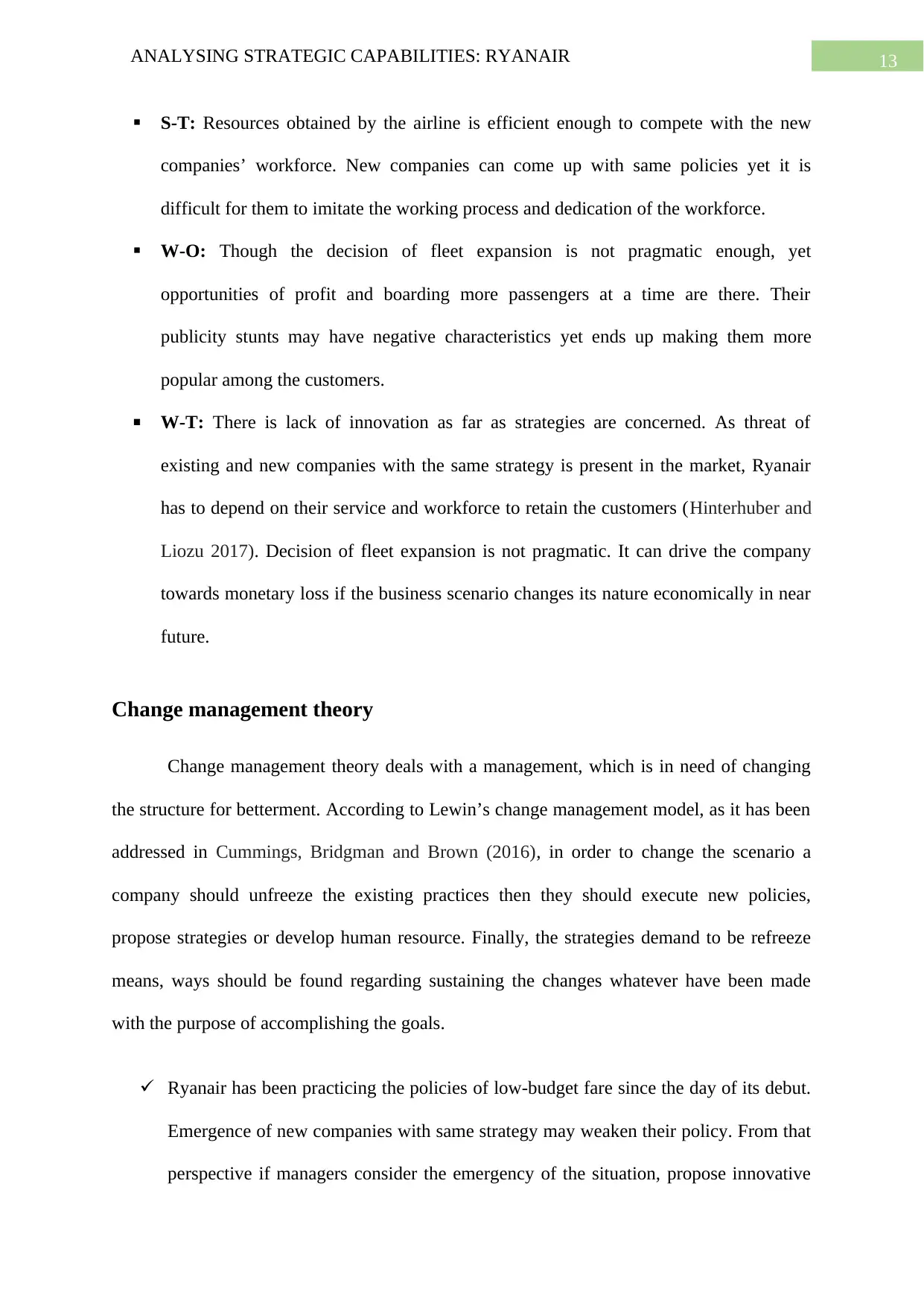
13ANALYSING STRATEGIC CAPABILITIES: RYANAIR
S-T: Resources obtained by the airline is efficient enough to compete with the new
companies’ workforce. New companies can come up with same policies yet it is
difficult for them to imitate the working process and dedication of the workforce.
W-O: Though the decision of fleet expansion is not pragmatic enough, yet
opportunities of profit and boarding more passengers at a time are there. Their
publicity stunts may have negative characteristics yet ends up making them more
popular among the customers.
W-T: There is lack of innovation as far as strategies are concerned. As threat of
existing and new companies with the same strategy is present in the market, Ryanair
has to depend on their service and workforce to retain the customers (Hinterhuber and
Liozu 2017). Decision of fleet expansion is not pragmatic. It can drive the company
towards monetary loss if the business scenario changes its nature economically in near
future.
Change management theory
Change management theory deals with a management, which is in need of changing
the structure for betterment. According to Lewin’s change management model, as it has been
addressed in Cummings, Bridgman and Brown (2016), in order to change the scenario a
company should unfreeze the existing practices then they should execute new policies,
propose strategies or develop human resource. Finally, the strategies demand to be refreeze
means, ways should be found regarding sustaining the changes whatever have been made
with the purpose of accomplishing the goals.
Ryanair has been practicing the policies of low-budget fare since the day of its debut.
Emergence of new companies with same strategy may weaken their policy. From that
perspective if managers consider the emergency of the situation, propose innovative
S-T: Resources obtained by the airline is efficient enough to compete with the new
companies’ workforce. New companies can come up with same policies yet it is
difficult for them to imitate the working process and dedication of the workforce.
W-O: Though the decision of fleet expansion is not pragmatic enough, yet
opportunities of profit and boarding more passengers at a time are there. Their
publicity stunts may have negative characteristics yet ends up making them more
popular among the customers.
W-T: There is lack of innovation as far as strategies are concerned. As threat of
existing and new companies with the same strategy is present in the market, Ryanair
has to depend on their service and workforce to retain the customers (Hinterhuber and
Liozu 2017). Decision of fleet expansion is not pragmatic. It can drive the company
towards monetary loss if the business scenario changes its nature economically in near
future.
Change management theory
Change management theory deals with a management, which is in need of changing
the structure for betterment. According to Lewin’s change management model, as it has been
addressed in Cummings, Bridgman and Brown (2016), in order to change the scenario a
company should unfreeze the existing practices then they should execute new policies,
propose strategies or develop human resource. Finally, the strategies demand to be refreeze
means, ways should be found regarding sustaining the changes whatever have been made
with the purpose of accomplishing the goals.
Ryanair has been practicing the policies of low-budget fare since the day of its debut.
Emergence of new companies with same strategy may weaken their policy. From that
perspective if managers consider the emergency of the situation, propose innovative

14ANALYSING STRATEGIC CAPABILITIES: RYANAIR
ways of customer retention, and sustain the practice of justified fare with occasional
discounts, company will not face issues at the time of environmental or economic
change. Check-in charges and policies are bothering the customers, realising that if
management can introduce web-check in process, then Ryanair can save money by
not employing anyone for that designation.
International expansion can be an effective strategic way to increase their market
share. Variations in execution, considering customers’ opinion can help to recognise
certain hidden opportunities, which were not realised before. Their new policy should
be to attract premium customers rather than only focusing on mass interest (Leong et
al.2015).
While performing the change, it can take a huge time to execute or adopt with the new
system. Managers should be cautious during this period and a pragmatic thought
process is necessary in order to take actions under critical situation like losing
customer loyalty or confusion among human resource regarding the new operations.
With the purpose of making change and sustaining that Ryanair should develop and
train their workforce accordingly, effective interpersonal communication can be
helpful while developing such practices via electronic mode as well (Lee and
Worthington 2014). The structured system with satisfied employees and customers
can lead towards excellence.
Strategic recommendation
I. As discussed in VRIO and TWOS analysis, in order to overcome threat of
competitors, not only operational excellence and service matter but also idea of business
expansion as well as introducing innovative policies can be helpful.
ways of customer retention, and sustain the practice of justified fare with occasional
discounts, company will not face issues at the time of environmental or economic
change. Check-in charges and policies are bothering the customers, realising that if
management can introduce web-check in process, then Ryanair can save money by
not employing anyone for that designation.
International expansion can be an effective strategic way to increase their market
share. Variations in execution, considering customers’ opinion can help to recognise
certain hidden opportunities, which were not realised before. Their new policy should
be to attract premium customers rather than only focusing on mass interest (Leong et
al.2015).
While performing the change, it can take a huge time to execute or adopt with the new
system. Managers should be cautious during this period and a pragmatic thought
process is necessary in order to take actions under critical situation like losing
customer loyalty or confusion among human resource regarding the new operations.
With the purpose of making change and sustaining that Ryanair should develop and
train their workforce accordingly, effective interpersonal communication can be
helpful while developing such practices via electronic mode as well (Lee and
Worthington 2014). The structured system with satisfied employees and customers
can lead towards excellence.
Strategic recommendation
I. As discussed in VRIO and TWOS analysis, in order to overcome threat of
competitors, not only operational excellence and service matter but also idea of business
expansion as well as introducing innovative policies can be helpful.
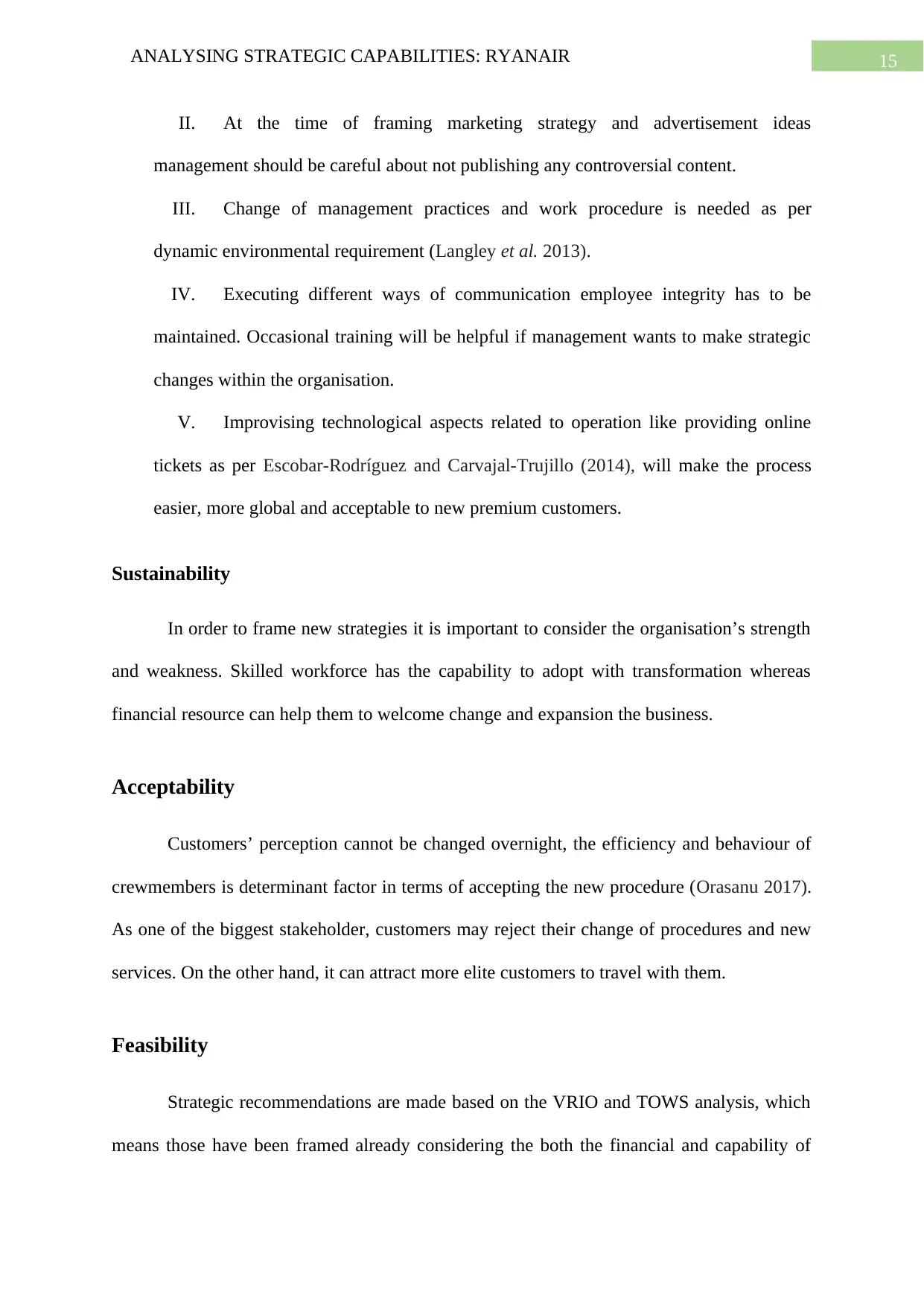
15ANALYSING STRATEGIC CAPABILITIES: RYANAIR
II. At the time of framing marketing strategy and advertisement ideas
management should be careful about not publishing any controversial content.
III. Change of management practices and work procedure is needed as per
dynamic environmental requirement (Langley et al. 2013).
IV. Executing different ways of communication employee integrity has to be
maintained. Occasional training will be helpful if management wants to make strategic
changes within the organisation.
V. Improvising technological aspects related to operation like providing online
tickets as per Escobar-Rodríguez and Carvajal-Trujillo (2014), will make the process
easier, more global and acceptable to new premium customers.
Sustainability
In order to frame new strategies it is important to consider the organisation’s strength
and weakness. Skilled workforce has the capability to adopt with transformation whereas
financial resource can help them to welcome change and expansion the business.
Acceptability
Customers’ perception cannot be changed overnight, the efficiency and behaviour of
crewmembers is determinant factor in terms of accepting the new procedure (Orasanu 2017).
As one of the biggest stakeholder, customers may reject their change of procedures and new
services. On the other hand, it can attract more elite customers to travel with them.
Feasibility
Strategic recommendations are made based on the VRIO and TOWS analysis, which
means those have been framed already considering the both the financial and capability of
II. At the time of framing marketing strategy and advertisement ideas
management should be careful about not publishing any controversial content.
III. Change of management practices and work procedure is needed as per
dynamic environmental requirement (Langley et al. 2013).
IV. Executing different ways of communication employee integrity has to be
maintained. Occasional training will be helpful if management wants to make strategic
changes within the organisation.
V. Improvising technological aspects related to operation like providing online
tickets as per Escobar-Rodríguez and Carvajal-Trujillo (2014), will make the process
easier, more global and acceptable to new premium customers.
Sustainability
In order to frame new strategies it is important to consider the organisation’s strength
and weakness. Skilled workforce has the capability to adopt with transformation whereas
financial resource can help them to welcome change and expansion the business.
Acceptability
Customers’ perception cannot be changed overnight, the efficiency and behaviour of
crewmembers is determinant factor in terms of accepting the new procedure (Orasanu 2017).
As one of the biggest stakeholder, customers may reject their change of procedures and new
services. On the other hand, it can attract more elite customers to travel with them.
Feasibility
Strategic recommendations are made based on the VRIO and TOWS analysis, which
means those have been framed already considering the both the financial and capability of
Secure Best Marks with AI Grader
Need help grading? Try our AI Grader for instant feedback on your assignments.
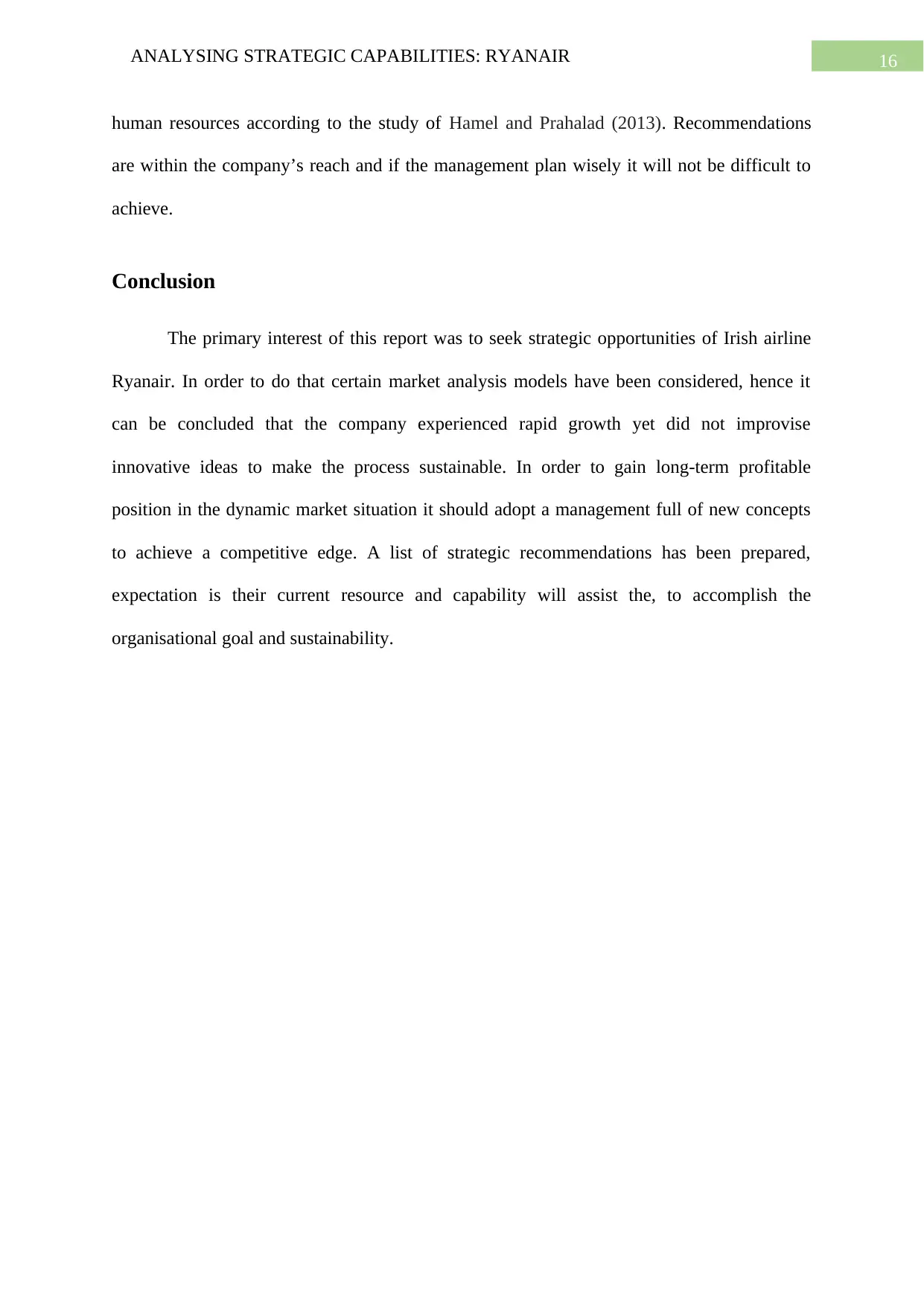
16ANALYSING STRATEGIC CAPABILITIES: RYANAIR
human resources according to the study of Hamel and Prahalad (2013). Recommendations
are within the company’s reach and if the management plan wisely it will not be difficult to
achieve.
Conclusion
The primary interest of this report was to seek strategic opportunities of Irish airline
Ryanair. In order to do that certain market analysis models have been considered, hence it
can be concluded that the company experienced rapid growth yet did not improvise
innovative ideas to make the process sustainable. In order to gain long-term profitable
position in the dynamic market situation it should adopt a management full of new concepts
to achieve a competitive edge. A list of strategic recommendations has been prepared,
expectation is their current resource and capability will assist the, to accomplish the
organisational goal and sustainability.
human resources according to the study of Hamel and Prahalad (2013). Recommendations
are within the company’s reach and if the management plan wisely it will not be difficult to
achieve.
Conclusion
The primary interest of this report was to seek strategic opportunities of Irish airline
Ryanair. In order to do that certain market analysis models have been considered, hence it
can be concluded that the company experienced rapid growth yet did not improvise
innovative ideas to make the process sustainable. In order to gain long-term profitable
position in the dynamic market situation it should adopt a management full of new concepts
to achieve a competitive edge. A list of strategic recommendations has been prepared,
expectation is their current resource and capability will assist the, to accomplish the
organisational goal and sustainability.
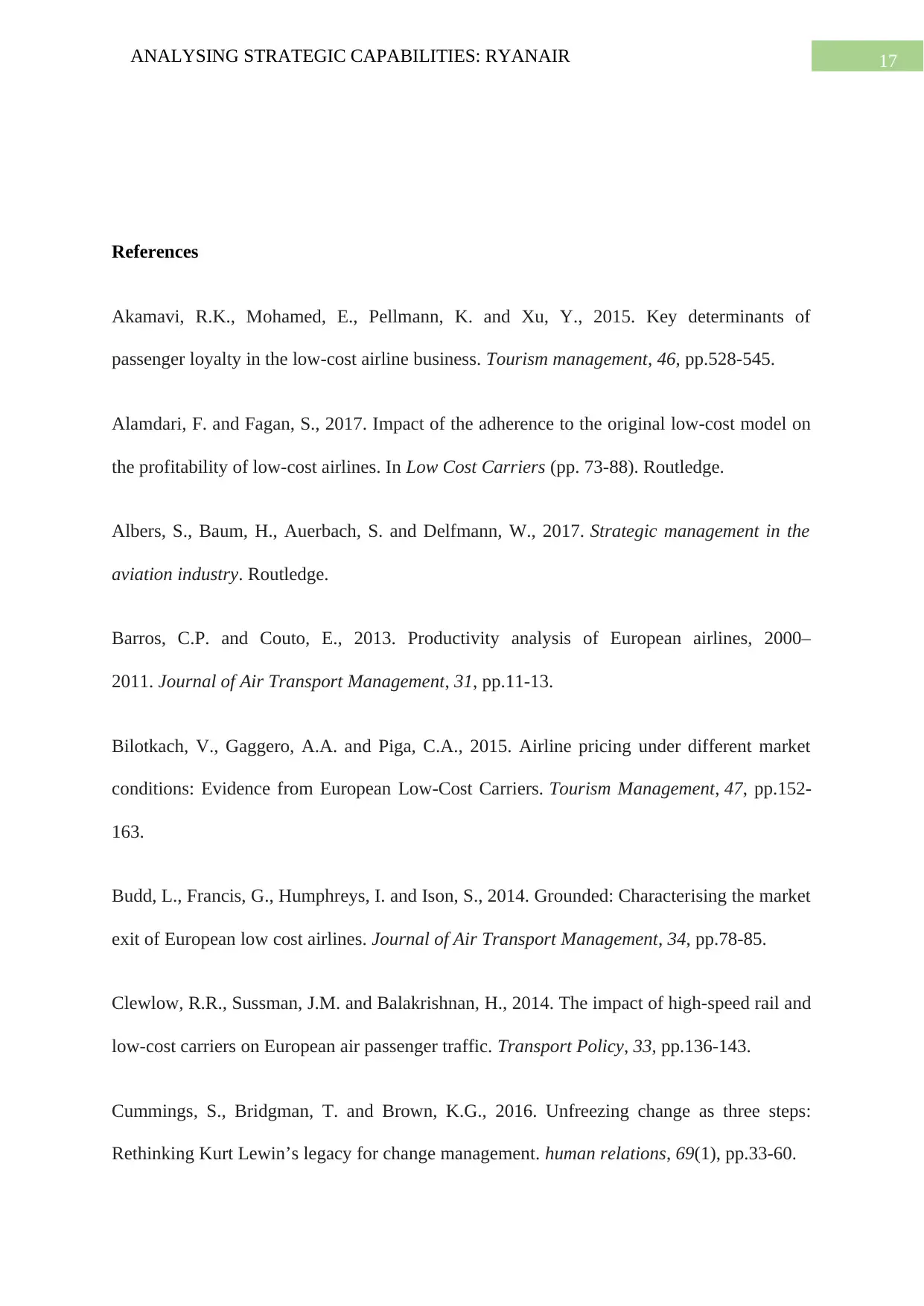
17ANALYSING STRATEGIC CAPABILITIES: RYANAIR
References
Akamavi, R.K., Mohamed, E., Pellmann, K. and Xu, Y., 2015. Key determinants of
passenger loyalty in the low-cost airline business. Tourism management, 46, pp.528-545.
Alamdari, F. and Fagan, S., 2017. Impact of the adherence to the original low-cost model on
the profitability of low-cost airlines. In Low Cost Carriers (pp. 73-88). Routledge.
Albers, S., Baum, H., Auerbach, S. and Delfmann, W., 2017. Strategic management in the
aviation industry. Routledge.
Barros, C.P. and Couto, E., 2013. Productivity analysis of European airlines, 2000–
2011. Journal of Air Transport Management, 31, pp.11-13.
Bilotkach, V., Gaggero, A.A. and Piga, C.A., 2015. Airline pricing under different market
conditions: Evidence from European Low-Cost Carriers. Tourism Management, 47, pp.152-
163.
Budd, L., Francis, G., Humphreys, I. and Ison, S., 2014. Grounded: Characterising the market
exit of European low cost airlines. Journal of Air Transport Management, 34, pp.78-85.
Clewlow, R.R., Sussman, J.M. and Balakrishnan, H., 2014. The impact of high-speed rail and
low-cost carriers on European air passenger traffic. Transport Policy, 33, pp.136-143.
Cummings, S., Bridgman, T. and Brown, K.G., 2016. Unfreezing change as three steps:
Rethinking Kurt Lewin’s legacy for change management. human relations, 69(1), pp.33-60.
References
Akamavi, R.K., Mohamed, E., Pellmann, K. and Xu, Y., 2015. Key determinants of
passenger loyalty in the low-cost airline business. Tourism management, 46, pp.528-545.
Alamdari, F. and Fagan, S., 2017. Impact of the adherence to the original low-cost model on
the profitability of low-cost airlines. In Low Cost Carriers (pp. 73-88). Routledge.
Albers, S., Baum, H., Auerbach, S. and Delfmann, W., 2017. Strategic management in the
aviation industry. Routledge.
Barros, C.P. and Couto, E., 2013. Productivity analysis of European airlines, 2000–
2011. Journal of Air Transport Management, 31, pp.11-13.
Bilotkach, V., Gaggero, A.A. and Piga, C.A., 2015. Airline pricing under different market
conditions: Evidence from European Low-Cost Carriers. Tourism Management, 47, pp.152-
163.
Budd, L., Francis, G., Humphreys, I. and Ison, S., 2014. Grounded: Characterising the market
exit of European low cost airlines. Journal of Air Transport Management, 34, pp.78-85.
Clewlow, R.R., Sussman, J.M. and Balakrishnan, H., 2014. The impact of high-speed rail and
low-cost carriers on European air passenger traffic. Transport Policy, 33, pp.136-143.
Cummings, S., Bridgman, T. and Brown, K.G., 2016. Unfreezing change as three steps:
Rethinking Kurt Lewin’s legacy for change management. human relations, 69(1), pp.33-60.
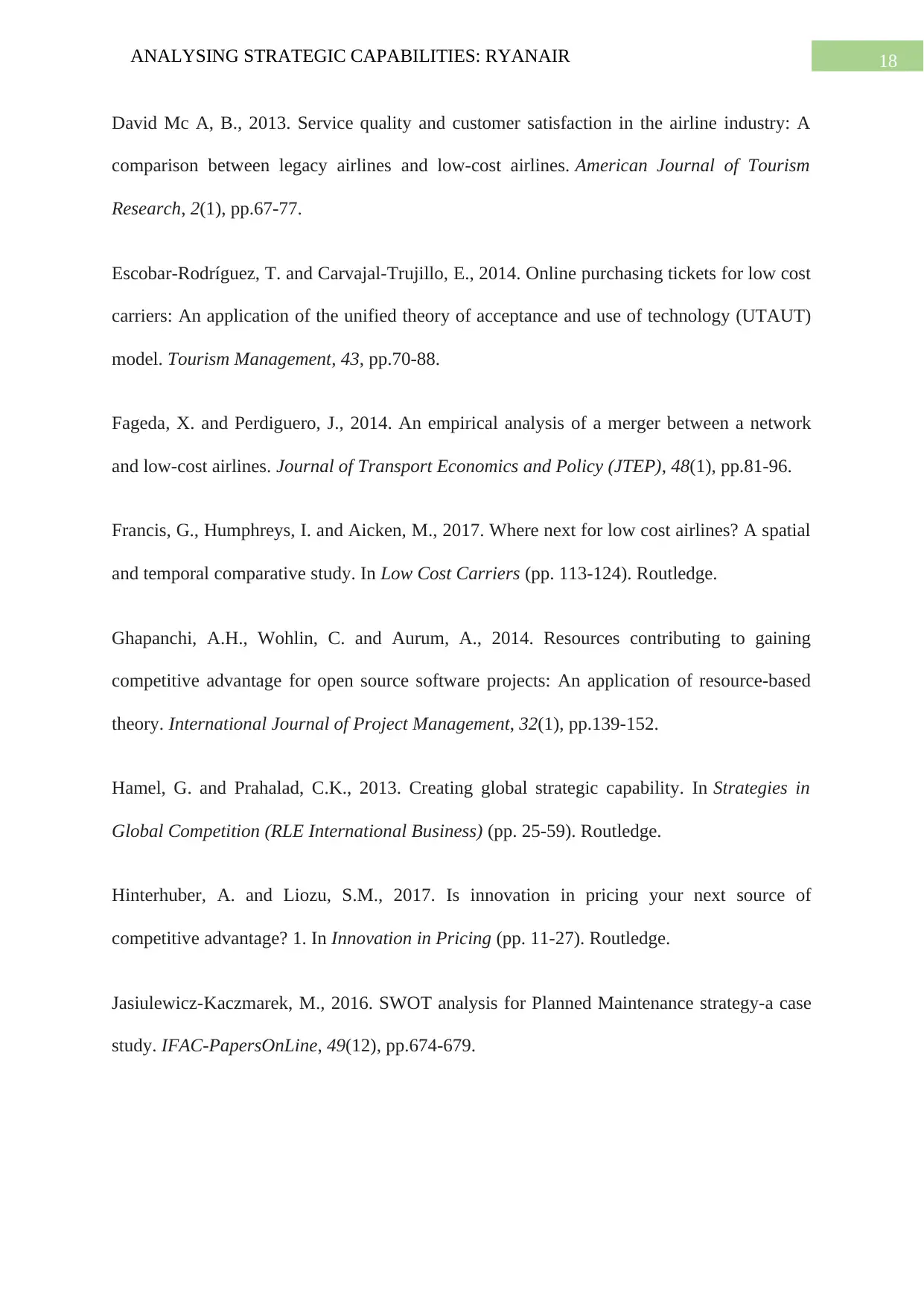
18ANALYSING STRATEGIC CAPABILITIES: RYANAIR
David Mc A, B., 2013. Service quality and customer satisfaction in the airline industry: A
comparison between legacy airlines and low-cost airlines. American Journal of Tourism
Research, 2(1), pp.67-77.
Escobar-Rodríguez, T. and Carvajal-Trujillo, E., 2014. Online purchasing tickets for low cost
carriers: An application of the unified theory of acceptance and use of technology (UTAUT)
model. Tourism Management, 43, pp.70-88.
Fageda, X. and Perdiguero, J., 2014. An empirical analysis of a merger between a network
and low-cost airlines. Journal of Transport Economics and Policy (JTEP), 48(1), pp.81-96.
Francis, G., Humphreys, I. and Aicken, M., 2017. Where next for low cost airlines? A spatial
and temporal comparative study. In Low Cost Carriers (pp. 113-124). Routledge.
Ghapanchi, A.H., Wohlin, C. and Aurum, A., 2014. Resources contributing to gaining
competitive advantage for open source software projects: An application of resource-based
theory. International Journal of Project Management, 32(1), pp.139-152.
Hamel, G. and Prahalad, C.K., 2013. Creating global strategic capability. In Strategies in
Global Competition (RLE International Business) (pp. 25-59). Routledge.
Hinterhuber, A. and Liozu, S.M., 2017. Is innovation in pricing your next source of
competitive advantage? 1. In Innovation in Pricing (pp. 11-27). Routledge.
Jasiulewicz-Kaczmarek, M., 2016. SWOT analysis for Planned Maintenance strategy-a case
study. IFAC-PapersOnLine, 49(12), pp.674-679.
David Mc A, B., 2013. Service quality and customer satisfaction in the airline industry: A
comparison between legacy airlines and low-cost airlines. American Journal of Tourism
Research, 2(1), pp.67-77.
Escobar-Rodríguez, T. and Carvajal-Trujillo, E., 2014. Online purchasing tickets for low cost
carriers: An application of the unified theory of acceptance and use of technology (UTAUT)
model. Tourism Management, 43, pp.70-88.
Fageda, X. and Perdiguero, J., 2014. An empirical analysis of a merger between a network
and low-cost airlines. Journal of Transport Economics and Policy (JTEP), 48(1), pp.81-96.
Francis, G., Humphreys, I. and Aicken, M., 2017. Where next for low cost airlines? A spatial
and temporal comparative study. In Low Cost Carriers (pp. 113-124). Routledge.
Ghapanchi, A.H., Wohlin, C. and Aurum, A., 2014. Resources contributing to gaining
competitive advantage for open source software projects: An application of resource-based
theory. International Journal of Project Management, 32(1), pp.139-152.
Hamel, G. and Prahalad, C.K., 2013. Creating global strategic capability. In Strategies in
Global Competition (RLE International Business) (pp. 25-59). Routledge.
Hinterhuber, A. and Liozu, S.M., 2017. Is innovation in pricing your next source of
competitive advantage? 1. In Innovation in Pricing (pp. 11-27). Routledge.
Jasiulewicz-Kaczmarek, M., 2016. SWOT analysis for Planned Maintenance strategy-a case
study. IFAC-PapersOnLine, 49(12), pp.674-679.
Paraphrase This Document
Need a fresh take? Get an instant paraphrase of this document with our AI Paraphraser
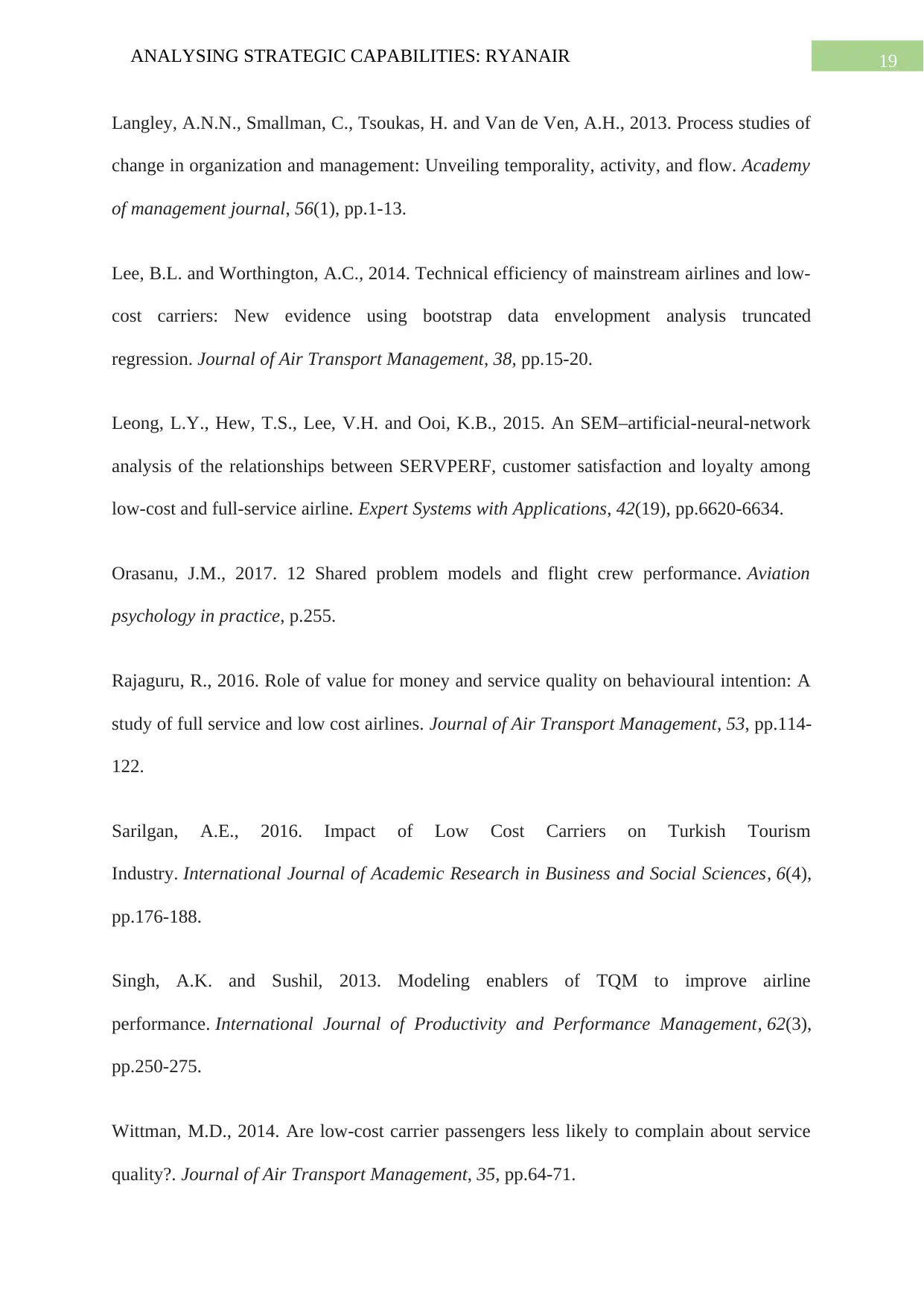
19ANALYSING STRATEGIC CAPABILITIES: RYANAIR
Langley, A.N.N., Smallman, C., Tsoukas, H. and Van de Ven, A.H., 2013. Process studies of
change in organization and management: Unveiling temporality, activity, and flow. Academy
of management journal, 56(1), pp.1-13.
Lee, B.L. and Worthington, A.C., 2014. Technical efficiency of mainstream airlines and low-
cost carriers: New evidence using bootstrap data envelopment analysis truncated
regression. Journal of Air Transport Management, 38, pp.15-20.
Leong, L.Y., Hew, T.S., Lee, V.H. and Ooi, K.B., 2015. An SEM–artificial-neural-network
analysis of the relationships between SERVPERF, customer satisfaction and loyalty among
low-cost and full-service airline. Expert Systems with Applications, 42(19), pp.6620-6634.
Orasanu, J.M., 2017. 12 Shared problem models and flight crew performance. Aviation
psychology in practice, p.255.
Rajaguru, R., 2016. Role of value for money and service quality on behavioural intention: A
study of full service and low cost airlines. Journal of Air Transport Management, 53, pp.114-
122.
Sarilgan, A.E., 2016. Impact of Low Cost Carriers on Turkish Tourism
Industry. International Journal of Academic Research in Business and Social Sciences, 6(4),
pp.176-188.
Singh, A.K. and Sushil, 2013. Modeling enablers of TQM to improve airline
performance. International Journal of Productivity and Performance Management, 62(3),
pp.250-275.
Wittman, M.D., 2014. Are low-cost carrier passengers less likely to complain about service
quality?. Journal of Air Transport Management, 35, pp.64-71.
Langley, A.N.N., Smallman, C., Tsoukas, H. and Van de Ven, A.H., 2013. Process studies of
change in organization and management: Unveiling temporality, activity, and flow. Academy
of management journal, 56(1), pp.1-13.
Lee, B.L. and Worthington, A.C., 2014. Technical efficiency of mainstream airlines and low-
cost carriers: New evidence using bootstrap data envelopment analysis truncated
regression. Journal of Air Transport Management, 38, pp.15-20.
Leong, L.Y., Hew, T.S., Lee, V.H. and Ooi, K.B., 2015. An SEM–artificial-neural-network
analysis of the relationships between SERVPERF, customer satisfaction and loyalty among
low-cost and full-service airline. Expert Systems with Applications, 42(19), pp.6620-6634.
Orasanu, J.M., 2017. 12 Shared problem models and flight crew performance. Aviation
psychology in practice, p.255.
Rajaguru, R., 2016. Role of value for money and service quality on behavioural intention: A
study of full service and low cost airlines. Journal of Air Transport Management, 53, pp.114-
122.
Sarilgan, A.E., 2016. Impact of Low Cost Carriers on Turkish Tourism
Industry. International Journal of Academic Research in Business and Social Sciences, 6(4),
pp.176-188.
Singh, A.K. and Sushil, 2013. Modeling enablers of TQM to improve airline
performance. International Journal of Productivity and Performance Management, 62(3),
pp.250-275.
Wittman, M.D., 2014. Are low-cost carrier passengers less likely to complain about service
quality?. Journal of Air Transport Management, 35, pp.64-71.
1 out of 20
Related Documents
Your All-in-One AI-Powered Toolkit for Academic Success.
+13062052269
info@desklib.com
Available 24*7 on WhatsApp / Email
![[object Object]](/_next/static/media/star-bottom.7253800d.svg)
Unlock your academic potential
© 2024 | Zucol Services PVT LTD | All rights reserved.




